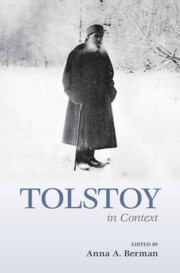Book contents
- Tolstoy in Context
- Tolstoy in Context
- Copyright page
- Contents
- Figures
- Notes on Contributors
- Preface
- Acknowledgments
- Note on Citations, Translations, and Transliterations
- Chronology
- Part I The Man
- Part II Russian Social and Political Contexts
- Part III Literature, the Arts, and Intellectual Life
- Part IV Science and Technology
- Part V Beyond Russia
- Chapter 29 Pacifism and the Doukhobors
- Chapter 30 America
- Chapter 31 India
- Chapter 32 Eastern Religion
- Chapter 33 English Varieties of Religious Experience
- Part VI Tolstoy’s Afterlife
- Suggested Further Reading
- Index
Chapter 31 - India
from Part V - Beyond Russia
Published online by Cambridge University Press: 05 January 2023
- Tolstoy in Context
- Tolstoy in Context
- Copyright page
- Contents
- Figures
- Notes on Contributors
- Preface
- Acknowledgments
- Note on Citations, Translations, and Transliterations
- Chronology
- Part I The Man
- Part II Russian Social and Political Contexts
- Part III Literature, the Arts, and Intellectual Life
- Part IV Science and Technology
- Part V Beyond Russia
- Chapter 29 Pacifism and the Doukhobors
- Chapter 30 America
- Chapter 31 India
- Chapter 32 Eastern Religion
- Chapter 33 English Varieties of Religious Experience
- Part VI Tolstoy’s Afterlife
- Suggested Further Reading
- Index
Summary
Tolstoy’s life and works have been interpreted in myriad ways in India. His emergence in the South Asian literary scene coincided with an important moment in the development of anti-colonial resistance to British imperial rule. In this moment, competing strands of ideological influence sought to interpret and introduce Tolstoy to the Indian reading public in their own way. This chapter studies two major streams into which these interpretations can be divided – the well-known one of Tolstoy as a pacifist, religiously based intellectual by Mohandas Gandhi, and the lesser-known, radical interpretation of Tolstoy as a figure of active resistance to issues ranging from landlordism to patriarchal oppression. The chapter investigates how the image of Tolstoy moved seamlessly between different cultural and linguistic entities across the region, providing insights into the category of “Indian literature” itself.
- Type
- Chapter
- Information
- Tolstoy in Context , pp. 255 - 262Publisher: Cambridge University PressPrint publication year: 2022

